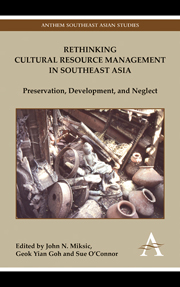Introduction: John N. Miksic
Published online by Cambridge University Press: 05 May 2012
Summary
Cultural resource management (CRM) is closely related to the management of economic development, tourism, preservation, and commodification. The ultimate goal of CRM is sustainable management of cultural resources; it inevitably entails the need to generate some form of economic return. The convergence between development and preservation is often tense because it entails compromise and negotiation between parties with conflicting interests. The frequently cited concept of “sustainability” is superficially simple but in reality is subject to many differing interpretations and fosters political, social and intellectual contestation. Conflicts between short-term versus long-term perspectives, local versus global priorities, and restoration versus regeneration are perennial sources of conflict between various stakeholders.
It is easy to formulate a literal, ideal definition of the term “sustainability”: a situation which enables, supports or seeks to ensure that core aspects of culture are packaged for tourism in such a way that they are not altered by commodification and continue to provide both income and psychological sustenance for their bearers until such time as those cultural practices are no longer seen as relevant by the descendants of the people who originally created them. As usual, the devil lies in applying the ideal concept to real cases. The implementation of a project always involves assumptions, predictions and compromises. Is sustainability an absolute or a relative concept? Can we evaluate the benefits of different levels of sustainability?
- Type
- Chapter
- Information
- Rethinking Cultural Resource Management in Southeast AsiaPreservation, Development, and Neglect, pp. xiii - xxiiPublisher: Anthem PressPrint publication year: 2011



